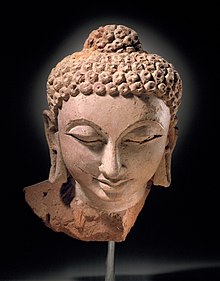Indo-Scythian art
[3] The presence of the Scythians in north-western India during the 1st century BCE was contemporary with that of the Indo-Greek Kingdoms there, and it seems they initially recognized the power of the local Greek rulers.
Indo-Scythian soldiers in military attire are sometimes represented in Buddhist friezes in the art of Gandhara (particularly in Buner reliefs).
Another relief is known where the same type of soldiers are playing musical instruments and dancing, activities which are widely represented elsewhere in Gandharan art: Indo-Scythians are typically shown as reveling devotees.
Excavations at the Butkara Stupa in Swat by an Italian archaeological team have yielded various Buddhist sculptures thought to belong to the Indo-Scythian period.
In particular, an Indo-Corinthian capital representing a Buddhist devotee within foliage has been found which had a reliquary and coins of Azes buried at its base, securely dating the sculpture to around 20 BC.
[6] A contemporary pilaster with the image of a Buddhist devotee in Greek dress has also been found at the same spot, again suggesting a mingling of the two populations.
[13] Indo-Scythians are known to have sponsored Buddhism, but also other religions, as visible from their inscriptions and archaeological remains in northwestern and western India, as well as from their contributions to pre-Kushana sculpture in Mathura.
[20] Several examples of in-the-round statuary have been found from the period of Sodasa, such as the torsos of "Vrishni heroes", discovered in Mora, about 7 kilometers west of Mathura.
[29] These statues are mentioned in the Mora Well Inscription nearby, made in the name of the Northern Satrap Sodasa circa 15 CE, in which they are called Bhagavatam.
Notable among the design motifs in the ayagapatas are the pillar capitals displaying "Persian-Achaemenian" style, with side volutes, flame palmettes, and recumbent lions or winged sphinxes.
[28] It has been suggested that the grapevine design had been introduced from the Gandhara area in the northwest, and maybe associated with the northern taste of the Satrap rulers.
[50] The calligraphy of the Brahmi script had remained virtually unchanged from the time of the Maurya Empire to the end of the 1st century BCE.
[54] In the 1st century BCE, the shape of Brahmi characters became more angular, and the vertical segments of letters were equalized, a phenomenon which is clearly visible in coin legends and made the script visually more similarly to Greek.
[54][57] This new writing style is particularly visible in the numerous dedicatory inscriptions made in Mathura, in association with devotional works of art.
[59] This artistic device ended with the sudden appearance of the Buddha, probably rather simultaneously in Gandhara and Mathura, at the turn of the millennium.
[60] The symbolism of this early statue is still tentative, drawing heavily on the earlier, especially Jain, pictural traditions of Mathura, still far from the exuberant standardized designs of the Kushan Empire.
[60] This depiction of the Buddha is highly similar to Jain images of the period, such as the relief of Jina Parsvanatha on an ayagapata, also dated to circa 15 CE.
[61] It has also been suggested that the cross-legged Buddhas may have derived from the depictions of seated Scythian kings from the northwest, as visible in the coinage of Maues (90-80 BCE) or Azes (57-10 BC).
[64] The Buddhist "Indrasala architrave", dated 50-100 CE, with a scene of the Buddha at the Indrasala Cave being attended by Indra, and a scene of devotion to the Bodhi Tree on the other side, is another example of the still hesitant handling of the human icon of the Buddha in the Buddhist art of Mathura.
[68] The three Vedic gods Indra, Brahma and Surya were actually first depicted in Buddhist sculpture, as attendants in scenes commemorating the life of the Buddha, even when the Buddha himself was not yet shown in human form but only through his symbols, such as the scenes of his Birth, his Descent from the Trāyastriṃśa Heaven, or his retreat in the Indrasala Cave.
[71] The Western Satraps are known for the construction and dedication of numerous Buddhist caves in Central India, particularly in the areas of Maharashtra and Gujarat.
[72][73] It is thought that Nahapana ruled at least 35 years in the region of Karla, Junnar and Nasik, giving him ample time for construction works there.
Ushavadata, son of Dinika, son-in-law of king Nahapana, the Kshaharata Kshatrapa, (...) inspired by (true) religion, in the Trirasmi hills at Govardhana, has caused this cave to be made and these cisterns.Success!
He constructed rest-houses, gardens and tanks at Bharukachchha (Broach), Dashapura (Mandasor in Malva), Govardhana (near Nasik) and Shorparaga (Sopara in the Thana district).
[84] Under Rudrasimha II, the Western Satraps are known to have maintained their presence in the Central Indian areas of Vidisha/Sanchi/Eran well into the 4th century: during his rule, in 319 CE, a Saka ruler inscribed the Kanakerha inscription,[87] on the hill of Sanchi mentioning the construction of a well by the Saka chief and "righteous conqueror" (dharmaviyagi mahadandanayaka) Sridharavarman (339-368 CE).
The construction of Buddhist monuments in the area of Gujarat during the later part of Western Satrap rule is attested with the site of Devnimori, which incorporates viharas and a stupa.





















